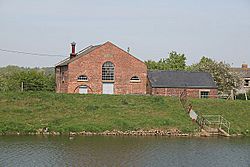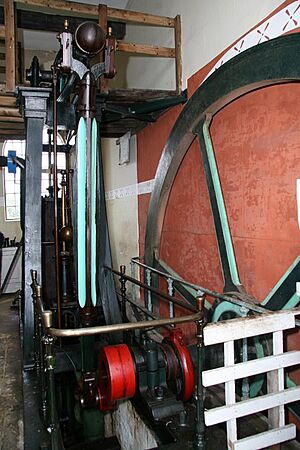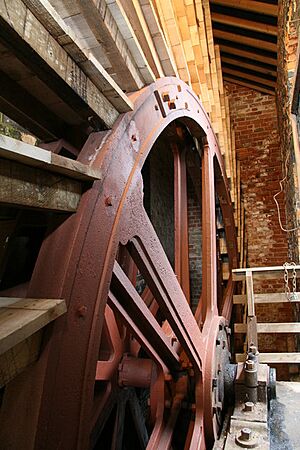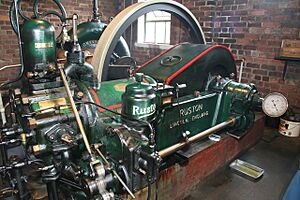Dogdyke Pumping Station facts for kids
The Dogdyke Pumping Station is a special old machine located near Tattershall, Lincolnshire, in England. Its main job was to drain water from about 2,500 acres (1,012 hectares) of land. This helped to make the land useful for farming. The idea to drain this land started way back in 1796. Later, in 1844, a group called the Witham Third District commissioners took charge of the project.
The main building you see today was built in 1856. It was made to hold a powerful steam engine. This new engine replaced older windmill-style pumps, which might have been used since the 1540s. These older pumps helped drain the land between the River Bain and the River Witham. The Dogdyke engine sent water into the River Witham. The water came from a long drain called The Dogdyke engine drain, which starts near Kirkstead.
Even though 1856 seems old, it was quite late for building this type of engine. Some records suggest an earlier engine was installed in 1841, but its exact location is not known. Today, the Dogdyke Pumping Station building is a protected historical site. It is listed as a Grade II ancient monument.
Contents
What Engines Are There?
The Dogdyke Pumping Station is home to several important engines. Each one played a role in keeping the land dry.
- Bradley and Craven Beam Engine: This is a steam engine with a large scoop wheel. It was built in 1856.
- Ruston & Hornsby Diesel Engine: This engine uses diesel fuel and has a centrifugal pump. It was built in 1940.
- Ruston & Hornsby Auxiliary Engine: This is a smaller diesel engine that helps start the larger one.
The Amazing Steam Engine
The old steam engine is carefully looked after by a group called the preservation trust. They even get it working and steaming on weekends during the summer! While another engine, the Pinchbeck Engine, is older, it can no longer be steamed. The trust believes the Dogdyke steam engine is the oldest working steam drainage engine still in operation.
This impressive engine was built by a company called Bradley & Craven Ltd from Wakefield. It has a huge flywheel that is about 16 feet (4.9 meters) across. The engine's cylinder is 24 inches (61 cm) wide and has a 48-inch (1.2-meter) stroke. Its design looks a bit like an 'A' frame, but it has unique decorative cast iron parts.
The giant scoop wheel is 24 feet (7.3 meters) in diameter. It spins at up to 7 rotations per minute. A special gearbox connects it to the engine, slowing the engine's speed by four times.
The first boiler for the steam engine was a "Cornish" type. It worked until 1909. It produced steam at 12 pounds per square inch (psi). The next boiler, installed after 1909, was a "Lancashire" type made by Fosters of Lincoln. This one delivered steam at 15 psi. While parts of this second boiler still exist, its back section was removed. A modern vertical boiler is now used to create steam for demonstrations.
The original chimney was very tall, about 100 feet (30 meters) high. Lightning struck it in 1922, making it shorter. It was completely taken down in 1941 when the station switched to using diesel engines.
Powerful Diesel Engines
The two diesel engines at Dogdyke are maintained by the Witham Third District Internal Drainage Board. They serve as a backup in case the nearby electric pumping station stops working. These diesel engines are usually run when the museum is open for visitors.
The main steam engine was replaced in 1940 by a Ruston & Hornsby 7XHR diesel engine. This engine is very powerful, with a capacity of 23.6 liters. It has one horizontal cylinder that is 10 inches (25 cm) wide and has an 18.5-inch (47 cm) stroke. It can produce 40 horsepower (30 kW) when running at 300 rotations per minute. This engine drives a 22-inch Gwynnes centrifugal pump.
There is also a smaller Ruston & Hornsby 1VTO auxiliary engine. This engine provides air to start the larger diesel engine. It also operates a small pump that helps prepare the main Gwynnes Limited pump to work. The 1VTO engine has one horizontal cylinder. It is 4 inches (10 cm) wide and has a 4-inch (10 cm) stroke. It can produce 5 horsepower (3.7 kW) when running at 1000 rotations per minute.
Visiting the Pumping Station
If you want to visit Dogdyke Pumping Station on a steaming day, you will need to drive down an unpaved road. Then, you will walk across a grassy area to reach the site. The area is mostly flat, but because it is an old historical site, access for people using wheelchairs might be limited.
When you visit, you can find toilets and buy teas. There is also some limited wheelchair access available.
More Places to Explore





